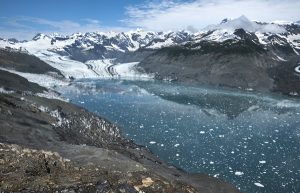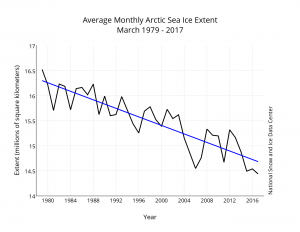Apr 20 2017
Retreat of the Cryosphere
 Patrick Burkhart and his colleagues recently published a review of their research on the cryosphere, which is a collective term for all the ice on the surface of the Earth. In addition to their review of the science, the new information they add is a photographic project documenting the retreat of glaciers around the globe.
Patrick Burkhart and his colleagues recently published a review of their research on the cryosphere, which is a collective term for all the ice on the surface of the Earth. In addition to their review of the science, the new information they add is a photographic project documenting the retreat of glaciers around the globe.
The retreat of the cryosphere is one of the many lines of evidence supporting the idea that the earth has been warming over the last half-century. There are several different ways to look at this. You can look at each pole to see the extent of ice coverage at their peak in winter and minimum in summer. You can look at specific ice sheets, like Greenland. You can look at glaciers. And you can look at total global ice, the cryosphere, which of course is the best single measure.
With regard to glaciers, the authors point out that there are many variables affecting the current size of any individual glacier. It is possible but difficult to account for all these variables and isolate one as a primary cause of melting. However, you can survey glaciers from around the world, which is a good way to control for local variables. When we do this we find there is a significant trend toward glacial retreat.
Satellite images confirm this, but also simple historical photographs also provide another line of evidence. The author surveyed such photographs to document changes in the extent of glaciers from the 1970s to the present. When updated photos were not available, they traveled to the respective glaciers to take them.
Part of the reason for focusing on the photographic evidence was not only that it is a useful supplemental source of data, but because, they argue, photos tell a story that may be easier to communicate to the public. Showing a series of photos showing glaciers in retreat tell their own story which is easy to grasp.
Of course you still need to trust that the scientists are being fair in how they are presenting the photos. Are they from comparable seasons, for example. This leaves the door open for anyone motivated to deny this evidence.
Regarding the satellite evidence for contraction of glaciers they write:
These observations provide robust documentation of ice loss. Arendt et al. (2013) reported a mass-balance for glaciers in the Gulf of Alaska of −65 ± 11 Gt/a from 2003 to 2010 from the Gravity Recovery and Climate Experiment (GRACE), which compared well with their determination of −65 ± 12 Gt/a from the Ice, Cloud, and land Elevation Satellite (ICESat) based upon glacier elevation changes.
They go on to further review the published evidence, with similar results.
They also point out a couple of factors significant to glaciers. Warming from increasing atmospheric concentrations of CO2 should and do cause relatively more warming at higher altitudes, where glaciers often exist. Therefore glacial melt will be greater than predicted for average global temperatures.
Further, as glaciers melt they expose darker land underneath, which absorbs more heat from the sun, resulting in a positive feedback loop increasing the melting of glaciers. You have probably noticed this effect on your driveway. Once the ice gets thin enough the sun’s rays are able to reach the dark pavement below, and this greatly accelerates ice melting.
Further, glaciers often exist in locations where the environment is very close to the melting point, and so small changes in temperature could have a significant effect on melting.
 Arctic sea ice (not covered in this paper) is another part of the story. There has been a steady decline of total arctic ice over the last 30 years. Here is the latest graph, showing a new low for maximum arctic ice in 2016. There has been a steady decline of 2.74% per decade.
Arctic sea ice (not covered in this paper) is another part of the story. There has been a steady decline of total arctic ice over the last 30 years. Here is the latest graph, showing a new low for maximum arctic ice in 2016. There has been a steady decline of 2.74% per decade.
Of course, year to year there is variability, even though the long term trend is obvious. During the last short term uptick the global warming deniers declared that arctic ice was “recovering.” They will probably say that again during the next upward fluctuation.
The story of antarctic ice coverage has been more complex. It has been slowly increasing over the last few decades, which of course has also been a talking point for global warming deniers. But, total polar ice has been decreasing. Further it seems that the extent of antarctic ice coverage has been increasing as an artifact of melting ice sheets leading to more ice in the surrounding oceans.
Remember, the arctic has no land mass. It is all sea ice. Antarctica is a continent with ice on top, so the dynamic is different.
In any case, in 2017 the ice figures for March show that both poles have reached a new minimum, with a sharp recent dip in total sea ice.
Let’s also not forget Greenland, which is losing about 281 billion metric tons of ice per year.
If we look at both poles, Greenland and Iceland, and the world’s glaciers, the picture is clear. The cryosphere is contracting, and apparently at an accelerating rate.
If there were no political implications to these established facts, I don’t see how there can be much debate about them. But of course, for those who don’t like the ultimate implications of melting ice – some of the proposed solutions to this apparent problem, they deny the problem (so-called solution aversion).
This is counterproductive. There is a strong and real scientific consensus that the globe is warming on average, the cyrosphere in total is contracting, and there are potential negative, or at least very expensive, consequences to this. There is also a strong consensus that the primary driver of this change is manmade release of CO2 into the atmosphere.
It is sad that so many people feel the need to deny the science with bad arguments, cherry picked data, and dubious logic, even appealing to implausible conspiracy theories. Rather, if you don’t like the proposed solutions, then come up with better ones. That is where the debate should be, not rehashing the science because you don’t like the results.
Interestingly, a recent review of the implications of climate change for the energy industry concludes that the fossil fuel industry is already doomed. The trends are clear, sustainable energy is gaining traction and is getting more cost effective, with the added benefit of not releasing CO2. Simply put, renewable energy sources are the future. As the authors say, that train has left the station. Getting it back is not going to happen.
The fossil fuel industry might as well get on board and start transitioning to the technologies of the future.






